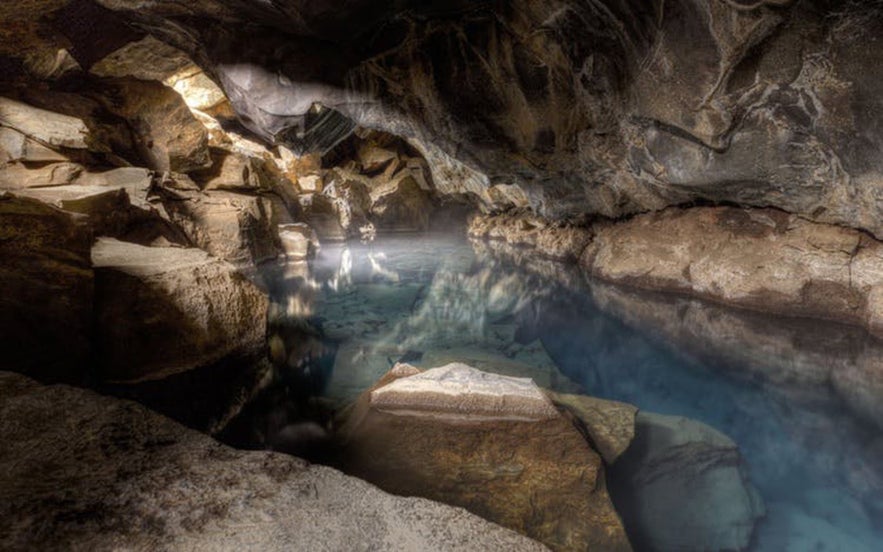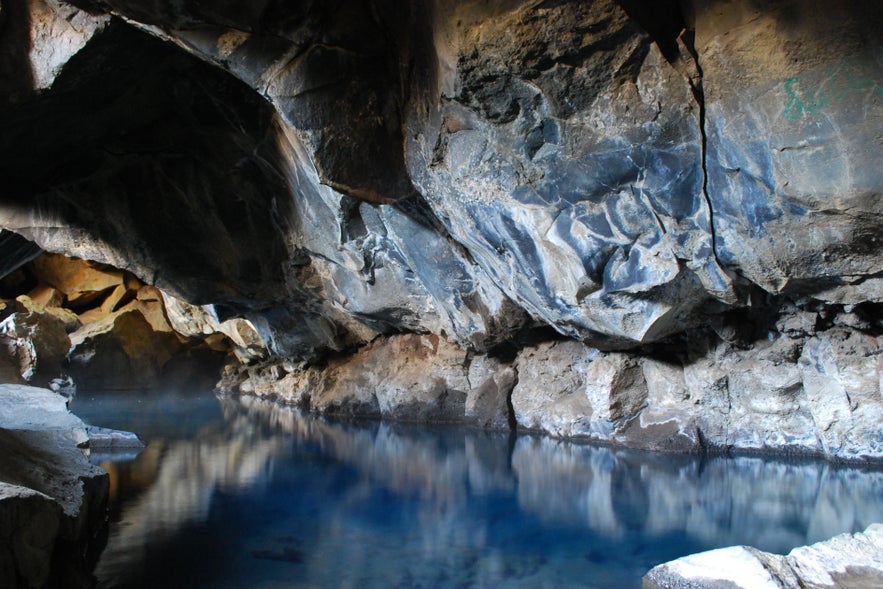
Grjótagjá is a small lava cave located near lake Mývatn in north Iceland, famous for featuring a beautiful geothermal hot spring in its depths.
Though it cannot be entered, the Mývatn area can be driven to by those who rent a car, take a tour of Myvatn or book a self-drive tour that travels north, such as this 10-Day Road Trip. The region is also visited on some multi-day trips, such as this 8-Day Adventure.
Miksi sisältöömme voi luottaa
Guide to Iceland on Islannin luotetuin matkailusivusto ja auttaa vuosittain miljoonia matkailijoita. Kaikki sisältömme on paikallisten asiantuntijoiden kirjoittamaa ja tarkastamaa – he tuntevat Islannin läpikotaisin. Voit luottaa siihen, että saat meiltä ajankohtaista, paikkansapitävää ja luotettavaa matkailutietoa.
Photo above from 3 in 1 Bundled Tours of Game of Thrones Locations with the Golden Circle, South Coast & Myvatn
History of Grjótagjá
Grjótagjá’s known history begins in the early 18th Century, where it was known to be the home of outlaw Jón Markússon. Throughout Iceland’s history, the icy, jagged rocks, total darkness and reputation for trolls meant that law-abiding folk avoided Iceland’s lava caves. They were thus the perfect spots for bandits who had been ostracised from Icelandic society by the parliament.
Little is known about Jón, but after his death, fears of his cave gave way to excitement at its potential. It was used by locals as a hot spring in the decades that followed until the 1970s, when Iceland’s unpredictable geothermal forces prevented them from doing so.
From 1975 to 1984, the Krafla volcanic system erupted nine times, making the water in the caves boiling and unusable.
After 1984, the temperature has slowly cooled, but has been known to rapidly heat again; in the surrounding area, liquid rock is just two kilometres (just over a mile) under the surface of the earth, meaning it can be very unpredictable.
As such, bathing is no longer allowed in Grjótagjá.
The lava cave and hot spring have such an ethereal, otherworldly beauty that they have attracted many Hollywood producers; HBO’s Game of Thrones even shot one of the season’s most iconic love scenes here.
If you don’t want spoilers, please skip ahead to ‘Getting to Grjótagjá’.
 Photo from Wikimedia, Creative Commons, by Petr Brož. No edits made.
Photo from Wikimedia, Creative Commons, by Petr Brož. No edits made.
In Season Three, Episode Four, protagonist Jon Snow and the wildling woman Ygritte consumate their relationship here, where Jon Snow ‘proves’ his abandonment of the Night's Watch.
In the televised version of the cave, there is a waterfall added with CGI, but otherwise, Grjótagjá is as it appears in reality.
Grjótagjá is far from the only place in Iceland used to build up the world of Westeros; in fact, it is not even the only one in the local area. Also in the Lake Mývatn area is the lava fortress of Dimmuborgir; in midwinter, this dramatic area was used to reflect the wildling camp of Mance Raider throughout Seasons Two and Three.
Also in the series are Mount Kirkjufell and the Reynisdrangar sea stacks in the penultimate episode of Season Seven, Vatnajökull glacier, on which ‘the Wall’ is built with CGI effects, and much of the landscape around Þingvellir National Park throughout. Icelandic mountain ranges can also be seen cut behind scenes filmed in countries such as Ireland and Croatia.
Getting to Grjótagjá
Grjótagjá is located conveniently in the Mývatn area, which is part of the most popular sightseeing route of north Iceland, the Diamond Circle, and on the Ring Road that encircles the country.
Reaching it and getting to the hot spring, however, requires a reasonable level of fitness and a little sense of adventure. There is a slightly rocky path that takes you from Dimmuborgir to the cave itself. As noted, however, the hot spring cannot be entered.









